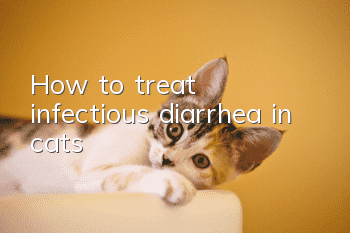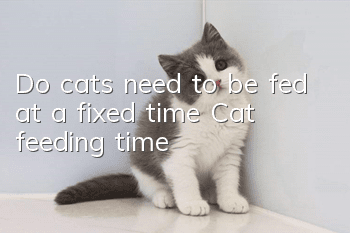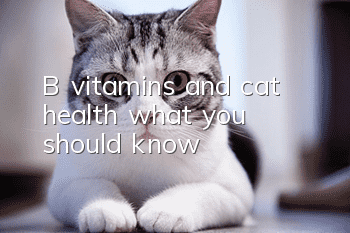How to treat infectious diarrhea in cats?

How to treat infectious diarrhea in cats? The so-called normal feces of cats vary depending on their diet, body temperature and exercise conditions. The water content in feces is significantly different between normal and various types of diarrhea.
1. Pathogen
1.1 Bacteria
1.1.1 Escherichia coli: Escherichia coli is a common flora in the intestinal tract of humans and animals, but it can cause disease under certain conditions. There are five types of Escherichia coli that cause infectious diarrhea; toxigenic Escherichia coli, pathogenic Escherichia coli, enterohemorrhagic Escherichia coli, invasive Escherichia coli and adhesive Escherichia coli. Among them, pathogenic Escherichia coli and enterohemorrhagic Escherichia coli are the two most important types of cat diarrhea. Clinically, the main symptoms are high fever, diarrhea, and vomiting. Both adults and children are susceptible to this disease, and the fatality rate is high. All cats are susceptible to this disease and have similar symptoms, but some cats only experience vomiting and panting, and most do not experience diarrhea.
1.1.2 Shigella dysenteriae: Shigella dysenteriae often causes infection in young cats. After infection, tiger cubs become depressed and unwilling to move or play. They frequently pass loose stools with pus and blood. Their stools are bright red and smelly. Symptoms of anemia and dehydration often occur.
1.1.3 Salmonella: This bacterium has a higher infection rate in young cats and has obvious clinical symptoms; many adult cats are carriers of Salmonella, but clinically the incidence of Salmonella is not high. Infection with this bacterium is mainly caused by unclean food and drinking water. Young artificially suckled animals are often caused by feeding spoiled milk powder.
1.1.4 Campylobacter jejuni: This bacterium is a zoonotic bacterium that can also affect poultry. It can invade the intestinal mucosa and produce enterotoxin, destroy intestinal villi and intestinal wall cells, and cause diarrhea. Both young and adult cats are susceptible.
1.1.5 Pasteurella: When this bacterium infects cats, the disease will become acute and the mortality rate will be high. Suffering animals suffer from lethargy, weight loss, fatigue, lying on the ground, elevated body temperature, mouth breathing, and often constipation first and then diarrhea.
1.2 Viruses
1.2.1 Feline parvovirus: This virus mainly causes feline panleukopenia, feline infectious enteritis or feline distemper (details) fever. It is one of the most serious infectious diseases in cats and is characterized by sudden high fever, vomiting, diarrhea, dehydration and obvious cytopenia. It is currently reported that almost all felines are infected, with young cats over one year old being the most susceptible, with mortality rates as high as over 90%. After some cats are infected with this disease, they do not show typical symptoms and die within 48 hours. The disease is distributed around the world, with an incidence rate in winter and spring.High, mainly transmitted through direct and indirect contact. The saliva, feces and urine of sick animals pollute the environment, and susceptible animals drink contaminated feed and water and become infected.
1.2.2 Rotavirus Rotavirus is a zoonotic virus. Since MEBUS was first isolated from calf diarrhea feces in 1965, it was found that the virus causes acute diarrhea and death in infants and young animals. The main pathogens are piglets, lambs, horses, dogs, cattle, rhesus monkeys, cats and other newborn animals. Non-bacterial diarrhea in newborn kittens is also mostly due to rotavirus infection. After the virus infects cats, the animals often show symptoms of depression, anorexia, vomiting, and watery diarrhea, which are spray-like. If not treated in time, they often die of dehydration. Kittens artificially breastfed with poisonous milk or milk powder sometimes show severe flatulence.
1.2.3 Coronavirus This virus is also a zoonotic virus, which mainly manifests respiratory and digestive tract symptoms. In cats, gastrointestinal symptoms are primarily caused by enterocoronaviruses. The animal's body temperature rises, appetite decreases, sometimes vomiting, diarrhea, and in severe cases dehydration.
1.2.4 Calicivirus After cats are infected with this virus, they mainly show respiratory symptoms, but sometimes they also have vomiting and diarrhea, and ulcers appear on the tongue and palate, which may be related to secondary bacterial infection.
2. Pathogenesis and clinical connection The mechanisms of diarrhea caused by various factors can be roughly divided into:
2.1 Toxin-mediated diarrhea. Bacteria do not invade the intestinal mucosal tissue. They only multiply in the intestine and produce toxins. The toxins are absorbed by the intestinal villi and produce a series of physiological and biochemical reactions to cause diarrhea. Toxigenic Escherichia coli is a representative of this category. Escherichia coli is a common conditional pathogen. When the immunity of animals is reduced due to internal and external factors, Escherichia coli will multiply and produce a large amount of toxins. The toxins destroy the brush border of intestinal villi and affect the absorption function of the intestine, thus causing diarrhea.
2.2 Invasive diarrhea: After bacteria and viruses infect animals, they enter the intestinal mucosa and use the body's substances to reproduce in large quantities, destroy the structure of the intestinal wall, and cause extensive inflammation of the intestinal mucosa, leading to diarrhea, such as Shigella dysenteriae, etc.
2.3 Clinical manifestations The common symptom of infectious diarrhea in cats is diarrhea, but it can be divided into: according to the pathological manifestations advocated:
Exudative diarrhea: Exudation is a basic feature of inflammation. After the pathogen invades the intestinal mucosa, it damages the intestinal wall, causes inflammation, and causes a large amount of exudate to enter the intestine. When the inflammation worsens, ulcers or even perforation of the intestinal wall may occur, forming abdominal inflammation. At this time, the diarrhea contains exudate and blood. If the bacterial disease is in the small intestine, due to intestinal peristalsis, the exudate will be evenly mixed with the feces, and sometimes there will be shed intestinal mucosa.
SecretoryDiarrhea: It is caused by enterotoxin. After the toxin is absorbed, it changes the permeability of intestinal microcirculation and destroys the osmotic balance inside and outside the intestinal wall. A large amount of water and inorganic salt cells enter the intestinal cavity from one side of the cell. The feces of animals with diarrhea appear as follows: Water sample, containing a small amount of debris. Feces contain a large amount of electrolytes, mainly potassium ions and sodium ions. There is no pus or blood in the feces. Diarrhea persists after fasting. Animals often suffer from severe dehydration, electrolyte imbalance and acidosis due to this, and lack of timely treatment. , often die.
3. Treatment and prevention
3.1 Treatment measures
For diarrhea caused by bacteria, the application of antibiotics is necessary. Due to the misuse of antibiotics, many drug-resistant strains have emerged. Therefore, before treatment, a drug sensitivity test should be conducted to select sensitive antibiotics for treatment. Drugs that improve intestinal motility such as atropine and 6542 mixture can also be used to reduce intestinal spasm and relieve diarrhea. Intestinal adsorbents and astringents such as Smecta, silica silver, silica silver, etc. can absorb toxins and reduce their poisoning to the intestinal wall. Some microbial preparations can re-establish the normal flora of the intestinal tract, which is especially suitable for newborn kittens that are artificially breastfed. For diarrhea caused by viruses, injection of specific antiviral serum is effective. Immunoglobulin, interferon, cell transfer factor, thymosin and other immunity-enhancing drugs can be used at the same time to improve the body's anti-viral ability.
- How to train a cat? Training a cat requires the correct stimulation method!
- How to help Garfield cat lower its body temperature when the weather is too hot?
- Why does a cat’s stomach growl?
- Learn the tips for raising Ragdoll cats and identify whether the feeding method is correct or not
- How to prevent zoonotic diseases
- What are cat nail covers?
- Why do cats like to use scratching posts so much?
- How to clean cat's chin
- Can Siamese cats eat human food?
- Which part of dogtail grass does a cat eat?



